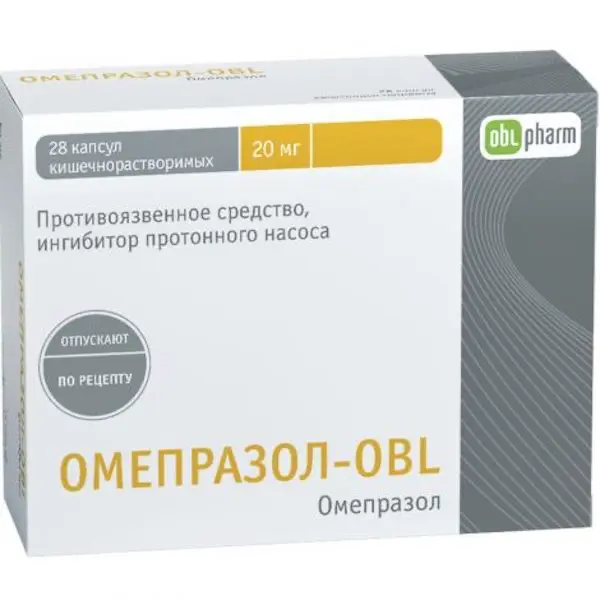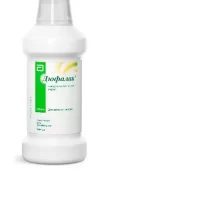Description
Omeprazole Pharmacodynamics
Omeprazole is a weak base. It is concentrated in acidic environment of secretory tubules of parietal cells of gastric mucosa, inhibits proton pump – H+/K+-ATPase enzyme. The effect of omeprazole on the last stage of the process of hydrochloric acid formation in the stomach is dose-dependent and provides highly effective inhibition of basal and stimulated hydrochloric acid secretion regardless of the stimulating factor.
Effects on gastric juice secretion
Omeprazole with daily oral administration provides rapid and effective inhibition of daytime and nighttime hydrochloric acid secretion.
Maximum effect is achieved within 4 days of treatment. In patients with duodenal ulcer, omeprazole in 20 mg dose causes steady reduction of 24-hour gastric acidity by at least 80%. This achieves an average maximum hydrochloric acid concentration reduction of 70% within 24 hours after pentagastrin stimulation.
In patients with duodenal ulcer omeprazole in dose of 20 mg with daily oral administration maintains in intragastric acidity at pH?3 for 17 hours a day on average. Inhibition of hydrochloric acid secretion depends on the area under the pharmacokinetic concentration-time curve of omeprazole rather than on the plasma concentration of the drug at a given time.
Action on Helicobacter pylori
Omeprazole has a bactericidal effect on Helicobacter pylori in vitro. Eradication of Helicobacter pylori when using omeprazole together with antibacterial agents is accompanied by rapid elimination of symptoms, a high degree of healing of gastrointestinal mucosal defects and long-term remission of peptic ulcer disease, which reduces the probability of complications such as bleeding, as effective as continuous maintenance therapy.
Other effects associated with inhibiting hydrochloric acid secretion
Patients taking drugs that reduce gastric acid secretion for a long period of time are more likely to have glandular cysts in the stomach; the cysts are benign and go away on their own with continued therapy.
Reduced secretion of hydrochloric acid in the stomach leads to a slightly increased risk of intestinal infections caused by Salmonella spp., Campylobacter spp. and Clostridium difficile.
During treatment with drugs that reduce gastric gland secretion, serum gastrin concentration increases. Due to decrease of hydrochloric acid secretion, concentration of chromogranin A increases (see section “Special Precautions”).
Indications
Adults
– Peptic ulcer, not associated with Helicobacter pylori (including relapse prevention);
– Gastroesophageal reflux disease (GERD);
– Eradication of Helicobacter pylori in infected patients with gastric and duodenal ulcer disease, as well as in other diseases requiring eradication (as part of combination therapy).
– Hypersecretory conditions (Zollinger-Ellison syndrome, stress ulcers of the stomach, polyendocrine adenomatosis, systemic mastocytosis and others).
– Prevention and treatment of damage to the mucous membrane of the stomach and duodenum, caused by taking non-steroidal anti-inflammatory drugs (NSAIDs): dyspepsia, mucosal erosions, peptic ulcers.
– Prevention of aspiration of acidic contents of the stomach into the airways during general anesthesia (Mendelsohn syndrome).
Children
In children over 2 years old and with body weight more than 20 kg in therapy of gastroesophageal reflux disease;
In children over 4 years of age and with body weight more than 20 kg in therapy of duodenal ulcer caused by Helicobacter pylori.
Safety and efficacy in other indications in pediatric patients have not been established
Contraindications
Hypersensitivity to omeprazole, substituted benzimidazoles or other drug components.
Concomitant use with the drugs nelfinavir, atazanavir, erlotinib, posaconazole.
Severe liver disease accompanied by hepatic insufficiency (only for 40 mg dose).
Lactose intolerance, lactase deficiency, glucose-galactose malabsorption syndrome
Omeprazole is contraindicated in children except for gastroesophageal reflux disease for children over 2 years of age and duodenal ulcer caused by Helicobacter pylori for children over 4 years of age (see section “Dosage and administration”).
Dosage and administration
- Swallow the capsule orally with plenty of water (contents should not be chewed), 30 minutes before a meal.
- If a patient cannot swallow the capsule as a whole, you can mix its contents with mildly acidified liquid, juice or fruit puree. Do not dissolve in carbonated beverages or milk.
- The resulting mixture should be consumed internally immediately after preparation.
Peptic ulcer of the stomach and duodenum, not associated with Helicobacter pylori (including relapse prevention) – patients resistant to treatment with other anti-ulcer drugs are prescribed at a dose of 40 mg / day. The course of treatment for duodenal ulcer is 2 weeks, if necessary, up to 4 weeks; for peptic ulcer – 4-8 weeks. - Gastroesophageal reflux disease (GERD): up to 40 mg per day, depending on the severity of esophagitis. Duration of basic course also depends on esophagitis severity and is 4-8 weeks. Maintenance therapy should be carried out in the lowest effective dose, including on demand and intermittent courses. The duration of maintenance therapy is determined by the physician.
- Eradication of Helicobacter pylori in infected patients with peptic ulcer disease of the stomach and duodenum, as well as in other diseases that require eradication (as part of combination therapy)
- First line (standard triple regimen)
Omeprazole 40 mg once a day + clarithromycin 500 mg twice a day + amoxicillin 1000 mg twice a day. To increase the efficiency of therapy, it is possible to prescribe Omeprazole 40 mg 2 times a day (doubling the standard dose) and to increase the course length from 7 to 10-14 days. - Second line (four-component)
Used when the standard triple therapy is ineffective or when the penicillin group is intolerant. - Bismuth tricalium dicitrate (120 mg 4 times a day) in combination with Omeprazole 40 mg once a day, tetracycline (500 mg 4 times a day) for 10 days.
- Third line and other alternative therapies are prescribed based on the study of individual sensitivity of Helicobacter pylori to antibacterial drugs.
- Hypersecretory conditions (Zollinger-Ellison syndrome, stress gastrointestinal ulcers, polyendocrine adenomatosis, systemic mastocytosis and others): the dose is selected individually, depending on the initial level of gastric secretion, usually starting with 40 mg once a day. If necessary, the dose is increased to 80-120 mg per day; in this case it is divided into 2-3 doses.
- Prevention and treatment of gastric and duodenal mucous membrane injuries caused by taking nonsteroidal anti-inflammatory drugs (NSAIDs): dyspepsia, mucosal erosions, peptic ulcers – Omeprazole is prescribed once in 40 mg daily for 4-8 weeks.
- Prevention of aspiration of acidic gastric contents into the airways during general anesthesia (Mendelsohn syndrome) – 40 mg once.
- Children
Over 2 years of age and with body weight over 20 kgs Omeprazole 20 mg 1 time per day should be used for treatment of gastroesophageal reflux disease. If necessary, the dose may be increased to 40 mg once daily. Course duration is 4-8 weeks. - In patients aged over 4 years and with body weight over 15-30 kg during treatment of duodenal ulcer caused by Helicobacter pylori, Omeprazole should be given in combination with 2 antibiotics: 10 mg Omeprazole, amoxicillin 25 mg/kg and clarithromycin 7.5 mg/kg. All are used simultaneously 2 times a day for 1 week.
- At the age over 4 years and with body weight 31-40 kg in treatment of duodenal ulcer caused by Helicobacter pylori, Omeprazole should be administered in combination with 2 antibiotics: 20 mg Omeprazole, 750 mg amoxicillin and 7.5 mg/kg clarithromycin. All are used simultaneously 2 times a day for 1 week.
- At the age over 4 years and with body weight over 40 kg in treatment of duodenal ulcer caused by Helicobacter pylori, Omeprazole should be administered in combination with 2 antibiotics: 20 mg Omeprazole, amoxicillin 1000 mg and clarithromycin 500 mg. All are used simultaneously 2 times a day for 1 week.





